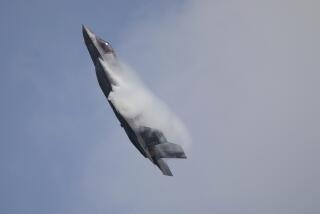Controllers Didn’t Respond; Jet Hit Indianapolis Motel : Pilot in Crash Asked How to Miss Homes
- Share via
DES PLAINES, Ill. — An Air Force pilot whose crippled jet fighter crashed into an Indianapolis airport hotel on Oct. 20, killing 10 people, tried but failed to get information from air traffic controllers which might have helped him avoid populated areas, tapes released Tuesday disclose.
Recordings of conversations between Maj. Bruce L. Teagarden, the pilot of the single-engine A-7D Corsair, and controllers show that Teagarden asked for the location of nearby housing before he overshot Runway 4-left while trying to land his powerless craft at the international airport.
However, controllers did not respond to Teagarden’s request, nor did they inform him that he was coming in too high to land safely. On his approach, Teagarden had been flying above a low-hanging cloud cover and could not see the terrain around the airport until seconds before he ejected from the rapidly descending plane.
Plowed Into Hotel Lobby
Teagarden parachuted to safety only after the plane broke through the clouds, but the aircraft clipped the edge of a bank building and plowed into the lobby of a Ramada Inn near the airport.
The tapes were made available by the Federal Aviation Administration’s regional office here. They show that, seconds after an unidentified controller informed Teagarden that he was six miles southwest of the airport, the pilot radioed back that he was “dead-sticking it in” (coming in with no engine power) and asked the controller to “say if there’s any kind of housing area close to me in case I have to get rid of this thing.”
No answer to Teagarden’s query was heard on the tape.
FAA officials said the accident investigation was under the control of the Air Force and refused to comment on the tapes. Identities of the controllers heard talking to Teagarden on the tape were not disclosed.
However, David Erickson, manager of the agency’s regional air traffic quality assurance division, said there are no guidelines governing how controllers should notify pilots in trouble about population concentrations to avoid.
Lack of Response
“There isn’t a set procedure,” Erickson said. “It’s just a question that’s asked and, if a controller knows, he would tell them. In this particular case, I can’t respond to why the controller did not answer that transmission . . . . I believe the controllers did what they felt was the right thing to do.”
Teagarden was en route from Pittsburgh to Nellis Air Force Base near Las Vegas when the engine of his Vietnam-era fighter “flamed out” about 15 miles south of Indianapolis at an altitude of 31,000 feet. “Mayday, Mayday, this is Chaps Two Four, I just lost an engine,” Teagarden radioed to controllers, referring to his plane by military code.
Controllers guided the plunging craft toward Indianapolis, radioed weather and other data to Teagarden and once asked whether he was able to steer his craft in order to let other aircraft land ahead of him. “Negative, I’ve got to get on the ground,” he radioed back.
“Chaps Two Four you’re over the airport now,” a controller in the airport tower radioed as Teagarden passed over the main runway. “Chaps Two Four is no joy,” he responded, using a military term which means “I don’t see it.”
With Teagarden’s view of the ground still obscured by clouds, a controller instructed the pilot to make a right turn in preparation for landing on an intersecting runway designated as Three One.
“Unable, unable, and it looks like I may have to get out of it,” Teagarden responded. Seconds later, he radioed in a shaky voice: “And I’m going down in a housing area.”
“Chaps Two Four, roger,” a controller replied. Another controller then said: “Indy approach, just hold everybody now, Chaps Two Four is going down.” And another voice is then heard to say: “He crashed out there. He’s burning.”
More to Read
Sign up for Essential California
The most important California stories and recommendations in your inbox every morning.
You may occasionally receive promotional content from the Los Angeles Times.













